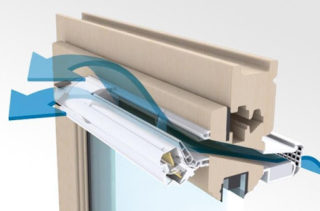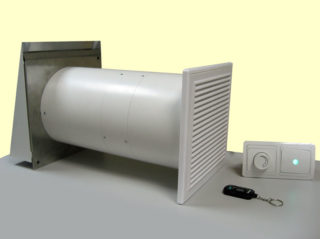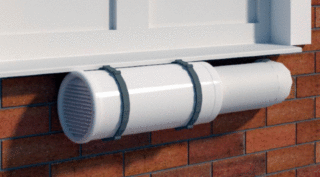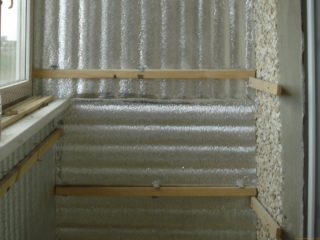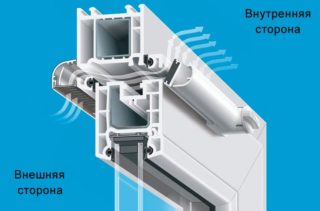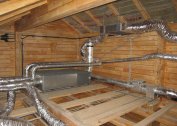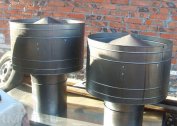Glazing of loggias and balconies is very popular, as it becomes possible to equip an additional insulated room. But when planning work, you need to take care of the organization of ventilation of the balcony. Without it, the problem of condensation, high humidity. All these factors provoke the appearance of mold and fungi that adversely affect the health of residents.
Problems with lack of ventilation on the balcony and loggia
Ventilation of the balcony will ensure safe living of people in the apartment and extend the life of the furniture, as well as building materials. If the doors and windows are hermetically closed, the humidity level rises due to the temperature difference in the street and in the room. It creates an ideal environment for the multiplication of fungus and bacteria. The walls are covered with mold; condensation is constantly observed on the glass. To avoid these problems, it is necessary to take care of high-quality ventilation on a glazed loggia.
Varieties and organization of ventilation on the balcony
Prior to the appearance of metal-plastic windows, problems with forced ventilation never arose. Wooden frames due to the structure of the material provided constant air exchange in a natural way.
When glazing loggias and balconies with metal-plastic windows, ventilation must be done. It can be of three types.
Natural ventilation
The easiest way to ventilate a room is to organize a natural airflow through open windows. To do this, it is recommended to install plastic windows with several opening positions. To keep the ventilation on the balcony constant, you can leave the sash on micro-ventilation. The double-glazed window will depart from the frame by 2 mm, this distance is enough to ensure optimal air flow.
This method has its drawback. Through the open windows, dust flies into the room and street noise is heard.
Supply and exhaust
A supply valve to the balcony is one way to get rid of mold. Supply and exhaust devices are mounted on windows or in walls. These are thin elongated structures that do not spoil the appearance, as they are absolutely invisible.
The main feature of the valves is that they provide constant air exchange, but the room is completely protected from dust and dirt.
Fan installation
An effective method of ventilation equipment is also the installation of fans on the wall of the building from the street. If the balcony is small, you can install one fan, which will simultaneously work on the output and the input. If the loggia is large in size, two fans are recommended. One will be responsible for the hood, the second - for the inflow. The hood on the balcony should be placed on top, the second appliance is mounted below.
DIY installation
You can make ventilation on the balcony yourself. There are three ways to place a supply system:
- only upstairs;
- just below;
- immediately below and above.
The latter option is the most optimal, as it provides maximum exhaustion.
For work you will need to prepare:
- hammer drill;
- fans.
The walls are made holes for fans. Devices are inserted into prepared openings.To ensure air flow, it is necessary that one fan blows air and the second blows. It is recommended that you initially think about a removable installation option to clean the device for the winter.
Ventilation on the balcony with plastic windows
The most optimal option to make a hood on a balcony with plastic windows is to install a valve. It’s easy to do the work yourself. The valve is a three-part device:
- Air intake outdoor unit, which will be installed on the frame from the side of the street. It is important to install a visor on top to protect the unit from precipitation.
- Sleeves of a telescopic type which are located in an internal part. They need to be installed in the frame profile. To do this, you will first need to drill a hole.
- Indoor unit - it is considered the most difficult part. This element consists of a nozzle through which air will pass into the room, a filter and a special mechanism that regulates the valve capacity. The block is installed to the profile opposite the external element.
If such a method of ventilation is organized on the balcony, it is necessary that the exhaust riser function well.
Window valves come in two types:
- mechanical;
- tame.
The former are regulated by a built-in electric actuator, which opens and closes the valve, thereby regulating air exchange. Manual valves are controlled by a rope. They are considered the most difficult to manage, since it is difficult to pick up the necessary inflow from the first try. Due to improper adjustment, the valve may freeze in winter.
Among the air valves, there are models that are not inserted into the holes, but instead of part of the sealing gum. In this way, air will pass through loose portions between the frame and the sash. This option is considered the most economical.
Heat recovery ventilation
One of the most advanced air circulation systems is forced ventilation with a recuperator. The main feature of the operation of such a system is the minimum cost of electricity. Air entering from the street is heated by a heat exchanger. The process occurs due to the heat that is in the exhaust air. Then the temperature is reached a comfortable indicator.
The ventilation system based on the recuperator is the most economical, multifunctional and modern, it meets all standards. Thanks to its installation, a stream of clean air is provided, which is optimal for humans. Simultaneously with the heating, the air masses are cleaned.
Improving ventilation efficiency on the balcony
Additional measures will help make ventilation more pronounced. First of all, it is recommended to insulate the balcony in order to increase the temperature on the glass inside. Having created such conditions, you can forget about the condensate.
To create optimal temperature conditions, it is recommended to do the following:
- Install an infrared or convector heater on the loggia. It is desirable that he had the function to set a specific temperature regime.
- During the overhaul of the balcony, you can insulate the walls and ceiling. It is best to use mineral wool or polystyrene foam for these purposes. All slots on the balcony should be covered with foam.
Thanks to high-quality insulation, the temperature inside the loggia will not drop below 18 degrees, therefore, condensate will not form.
You can deal with condensate not only by installing good ventilation, warming walls and ceilings, but also by other methods:
- install visors over balconies, it is important to avoid snow sticking to the glass;
- eliminate all leaks;
- adjust the drain.
Until ventilation is established, do not grow winter gardens on the loggias. This will inevitably lead to condensation.
Features of ventilation in the winter
Ventilation on loggias with double-glazed windows becomes most relevant in winter. The difference between the temperatures inside and outside increases, which leads to increased condensation.
If there was a fan on the balcony, with the onset of cold weather, chilled air begins to flow through the blades. This leads to the atmosphere becoming uncomfortable. To avoid this problem, it is recommended to use only natural ventilation in the winter.
The fan must be removed and the ventilation grill on the balcony closed. This can be done using a chipboard sheet, which should be larger in size than the hole from the device. Often the fan is not removed, but simply a plug is installed on top of it. You can find equipment with doors for sale. This is the best option for mounting on a loggia.
Ventilation on the loggia and balcony is important. With its help, an optimal microclimate is maintained, which allows you to keep furniture and decoration materials intact, and also preserves the health of apartment residents.

